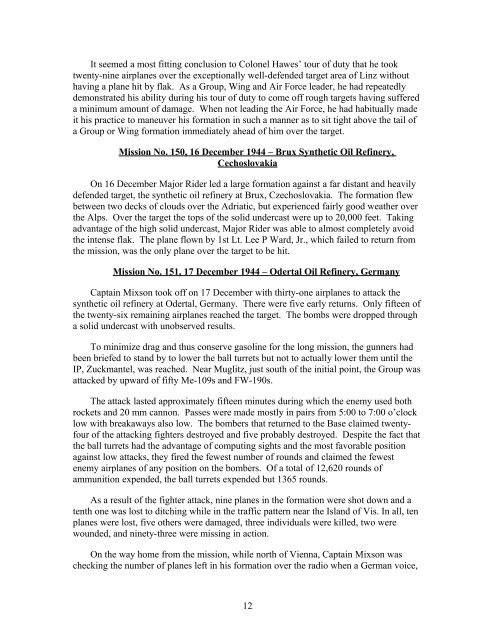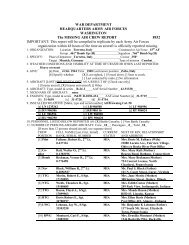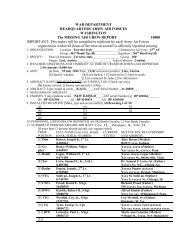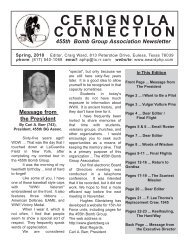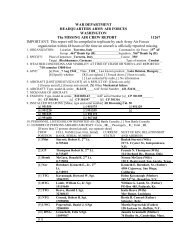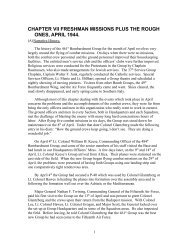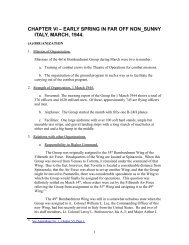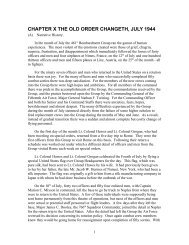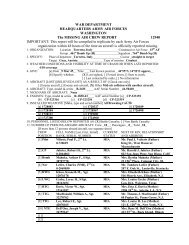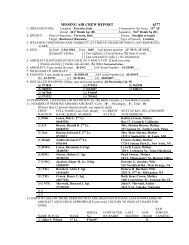December 1944 - 461st Bombardment Group
December 1944 - 461st Bombardment Group
December 1944 - 461st Bombardment Group
- No tags were found...
You also want an ePaper? Increase the reach of your titles
YUMPU automatically turns print PDFs into web optimized ePapers that Google loves.
It seemed a most fitting conclusion to Colonel Hawes’ tour of duty that he took<br />
twenty-nine airplanes over the exceptionally well-defended target area of Linz without<br />
having a plane hit by flak. As a <strong>Group</strong>, Wing and Air Force leader, he had repeatedly<br />
demonstrated his ability during his tour of duty to come off rough targets having suffered<br />
a minimum amount of damage. When not leading the Air Force, he had habitually made<br />
it his practice to maneuver his formation in such a manner as to sit tight above the tail of<br />
a <strong>Group</strong> or Wing formation immediately ahead of him over the target.<br />
Mission No. 150, 16 <strong>December</strong> <strong>1944</strong> – Brux Synthetic Oil Refinery,<br />
Cechoslovakia<br />
On 16 <strong>December</strong> Major Rider led a large formation against a far distant and heavily<br />
defended target, the synthetic oil refinery at Brux, Czechoslovakia. The formation flew<br />
between two decks of clouds over the Adriatic, but experienced fairly good weather over<br />
the Alps. Over the target the tops of the solid undercast were up to 20,000 feet. Taking<br />
advantage of the high solid undercast, Major Rider was able to almost completely avoid<br />
the intense flak. The plane flown by 1st Lt. Lee P Ward, Jr., which failed to return from<br />
the mission, was the only plane over the target to be hit.<br />
Mission No. 151, 17 <strong>December</strong> <strong>1944</strong> – Odertal Oil Refinery, Germany<br />
Captain Mixson took off on 17 <strong>December</strong> with thirty-one airplanes to attack the<br />
synthetic oil refinery at Odertal, Germany. There were five early returns. Only fifteen of<br />
the twenty-six remaining airplanes reached the target. The bombs were dropped through<br />
a solid undercast with unobserved results.<br />
To minimize drag and thus conserve gasoline for the long mission, the gunners had<br />
been briefed to stand by to lower the ball turrets but not to actually lower them until the<br />
IP, Zuckmantel, was reached. Near Muglitz, just south of the initial point, the <strong>Group</strong> was<br />
attacked by upward of fifty Me-109s and FW-190s.<br />
The attack lasted approximately fifteen minutes during which the enemy used both<br />
rockets and 20 mm cannon. Passes were made mostly in pairs from 5:00 to 7:00 o’clock<br />
low with breakaways also low. The bombers that returned to the Base claimed twentyfour<br />
of the attacking fighters destroyed and five probably destroyed. Despite the fact that<br />
the ball turrets had the advantage of computing sights and the most favorable position<br />
against low attacks, they fired the fewest number of rounds and claimed the fewest<br />
enemy airplanes of any position on the bombers. Of a total of 12,620 rounds of<br />
ammunition expended, the ball turrets expended but 1365 rounds.<br />
As a result of the fighter attack, nine planes in the formation were shot down and a<br />
tenth one was lost to ditching while in the traffic pattern near the Island of Vis. In all, ten<br />
planes were lost, five others were damaged, three individuals were killed, two were<br />
wounded, and ninety-three were missing in action.<br />
On the way home from the mission, while north of Vienna, Captain Mixson was<br />
checking the number of planes left in his formation over the radio when a German voice,<br />
12


